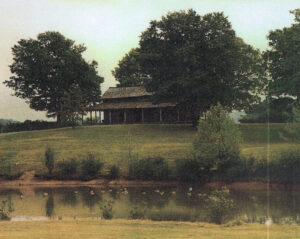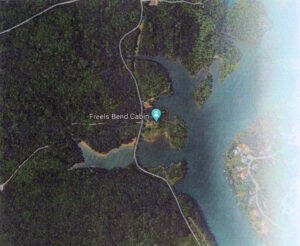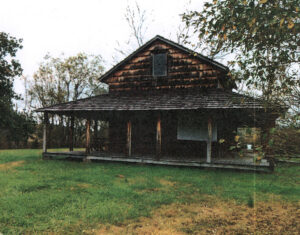Freels Cabin
Oak Ridge, Tennessee
Listed on the National Register of Historic Places in 1991


Freels Cabin is located on a rise overlooking the Clinch Riverit is among the earliestcabins built in Anderson County.
Edward Freels arrived in Tennessee with his family in the late 1790s.

Coming from North Carolina the Freel’s family became some of
the earliest European settlers in Anderson County.
Roadmaps from 1801 and 1807 show that the Freels had purchased several
hundred acres around the Clinch River.
Freels Cabin is located on a rise overlooking the Clinch River. It is among the earliest cabins built in Anderson County. This cabin is one of only two that I know of, that are still standing in the county. The other log cabin is over by Bull Run Steam Plant located on private property. Freels Bend Cabin was built by Edward Freels and is composed of two log rooms with a chimney in between them. These simple log rooms are called ‘pens’ by Preservationists.
Edward Freels arrived in Tennessee with his family in the late 1790s. Coming from North Carolina, his family became some of the earliest European settlers in Anderson County. They arrived in the 1790s but didn’t construct the first pen of the cabin until around c. 1810.
The cabin’s exterior and interior appearance generally reflect the period of use, with concrete daubing (between the timbers) and wraparound porch added during the 1940s.
Roadwork maps from 1801 and 1807 indicate that the Freels had purchased several hundred acres around the Clinch River. I want to point out that when the cabin was built (c 1810), the level of the Clinch River level wasn’t as hich and wasn’t as stable. TVA didn’t build the dams, stabilizing the water flow, until 100 years later. “God willinc and the Creeks don’t Rise!”
All of this area would later become known as Freels Bend. The Freels raised corn and cattle on the lands adjacent to the Clinch River. The family expanded the cabin around 1844, by building the second, larcer room (or log pen) to the East side (river side) of the cabin. They added this second room along with a limestone chimney positioned between the two rooms of the cabin, with a fireplace in each room. This simple double-pen log structure is characteristic of early settlement in central and eastern Tennessee durinc the early years of the formation of the state.
The exact sale date is unknown, but the majority of the Freels’ land, including the cabin was sold to Howard Van Gilder, Sr., during the early twentieth century. In 1942, the federal government acquired the house and 813 acres of land for the development of ORNL. Freels Bend was just one of many similar properties acquired by the War Department at the time. Approximately 59,000 acres located between the Clinch River and Black Oak Ridge were targeted for the construction of one of three federal research facilities dedicated to the development of the atomic bomb. In less than three years, a collection of small, rural farming communities was transformed into one of the largest industrial complexes in the world. Most of the pre-existing structures were demolished, although a number of buildings remained in use as housinc or as other facilities for project employees and their families. Freels Cabin was one such building, repurposed as a picnic and recreational area.
Although the Freels family
arrived in the 1790s, they
didn’t start building their
cabin until around 1810.
Building a cabin from
scratch, by hand, was a
huge amount of work.
Remember every bit of
work was done by hand.
The following videos demonstrate the techniques that the pioneers used to construct the early cabins..
Bethel Valley
1998 Interviews
Life Back Then
- Maude Lane
- S.E. Coley
- Dorothy Moneymaker
- Barbara McCall-Fly
- Velma Blank
- Dot Anderson Bushell
Self-sufficient, extremely hard-working, practical, humble, perseverant. They were stronger than we are today, `tougher’, life was really hard, most of the time they had to work from sun-up to sun-down, back then, even the children. They were consequently more realistic about the hardships of life than we are.
Interviewer: What was your favorite thing to do as a kid? Tell me about your childhood around here. What did you do as the child of a farmer?
Unknown: Well, we made our own wagons, and we rode over the hills and climbed trees and swung out of them and fell. I could hold my own with any of those boys.
I could shoot a gun as good as they could. They didn’t bother me, we’ll put it that way. We played in the creek all the time (White Oak Creek). My oldest brother threw me in the Creek one time and told me to sink or swim. I can remember sitting on the bottom of that Creek. I sunk. We just fought and scratched and stayed hidden from Mom so we wouldn’t have to do anything.
Interviewer: Did you feel as though your family’s personality changed as a result of the move?
Miss Lane: It did. We didn’t even have electricity until we moved out of the valley. Our refrigeration was a spring right down over there that comes out from under the hill. It was where we kept our stuff, or a cellar under the house. We could take our milk and butter that we didn’t want to spoil, and mother put it in crocs. I don’t know if you know what a croc is or not, but mother would put it down in that and put a lid on top of it. Set it down in the creek and nobody bothered it. Everybody’s crock was marked, and everybody knew whose, was whose, and nobody bothered it. That was one thing you didn’t do was go around bothering other people’s property.
Interviewer: Was the area primarily farms?
Mr. Coley: Yes, it was in fact there was practically nothing but farming then there were a lot of Peach orchards that hired people during the harvest season and that gave us teenagers money to spend that we wouldn’t have had otherwise.
Interviewer: Tell us what farm life was like back in those days, in about 1916?
Mr. Coley: We just farmed, we didn’t have tractors and things like we do now. We had teams of mules and stuff like that too, and we went out that they hope to clean the weeds out of the gardens and cornfields.
In places we mowed our hay with a mowing machine and raked it with the mules and everything.
We just had a good farm living, we grew a lot of what we ate, and everything you know we’d save. We’d have a wheat crop and stuff like that, and we’d sell stuff it to buy the staples that we would need for the year.
You know, we had to get up early in the morning and when we were in school, we’d have to go out and milk about two cows before we went to school. Carry up water to the house for Mama. We just worked from daylight maybe until the sun went down on the farm.
Interviewer: Did people go to big towns like Knoxville a lot back then?
Mr. Coley: Oh yes, if you wanted to go and buy fine clothes you had to go to Knoxville. There were a few horses a few people rode horseback or had a horse buggy. Many of the people walked. I’m 83 years old, (in 1998, so born in 1915). So that was a long time ago back then.
Mr. Coley: I want to tell you something I remember as I was growing up. At a certain time of year, and I guess it was the fall of the year, but I’m not for sure about that, they would have a drive of animals to the Knoxville Market. Most of the time it was cattle they would start, I don’t know where they started, but any farmer that was along the way added to it and they went up with them.
My daddy would point it out to me and show me the way that they would go. One person from each farm went with their group of animals and they would walk the trail up by our house to Knoxville.
Ruby Shanks lived there for a few years in the 1940s, when she was a teenager. Shanks said she and her parents, and four siblings lived in the cabin for about two years starting in October 1941. They had no running water, fished in the Clinch River, and raised cattle and horses. The children trekked a long distance, all the way from Freels Bend to where a stoplight is now located at Y-72 National Security Complex, to catch their school bus. Her father was a farmer and miner who worked for Roane-Anderson Company during World War II. She recalled plucking chickens for 50 cents an hour.
This information was provided from a presentation by Elizabeth Krispin to the Anderson County Historical Society, and has been posted by permission of the author.
Elizabeth Ann Krispin
Oak Ridge National Laboratories